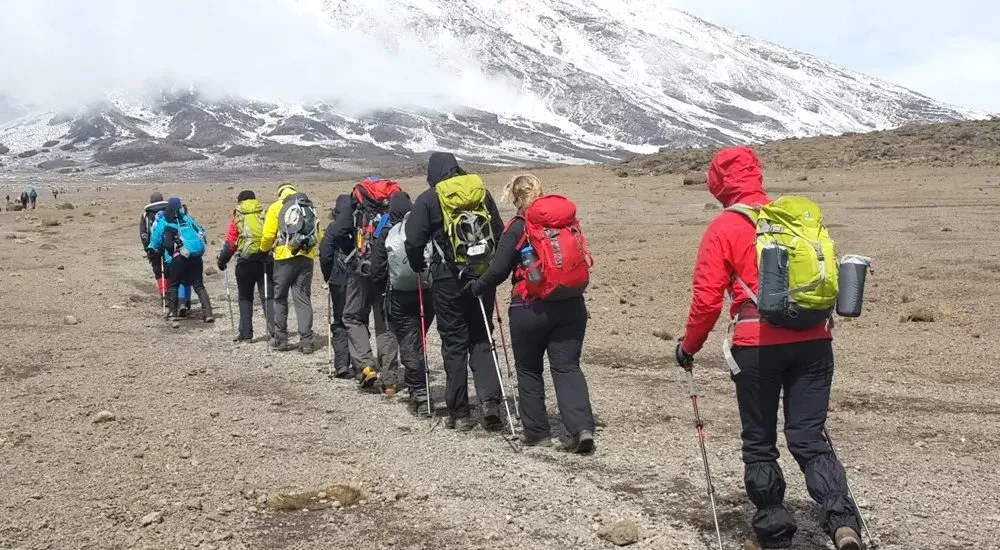Conquering the Roof of Africa: The Ultimate, In-Depth Guide to All Kilimanjaro Climbing Routes
Imagine standing at the edge of the world, gazing up at a colossal, icy summit piercing the clouds. Kilimanjaro, Africa’s tallest mountain, beckons adventurers from every corner of the globe. But with so many routes—each with its own character, challenges, and scenery—how do you choose the best path to reach the “Roof of Africa”?
Welcome to your ultimate guide. Whether you’re a seasoned trekker, a first-time adventurer, or someone simply dreaming of standing atop this majestic mountain, this comprehensive overview will equip you with everything you need to know about Kilimanjaro’s eight main routes: Marangu, Machame, Rongai, Lemosho, Umbwe, Shira, Northern Circuit, and Kilema.
Let’s embark on this journey together—diving deep into each route’s terrain, duration, pros and cons, best suited climbers, and insider tips to maximize your chances of success. By the end, you’ll not only be informed but inspired to take your first step toward the summit.
Why Climb Kilimanjaro?
The Highest Peak in Africa: Standing at 5,895 meters (19,341 feet), Kilimanjaro is the continent’s highest point and one of the Seven Summits—an achievement for mountain climbers worldwide.
A Non-Technical Climb: Unlike many high peaks, Kilimanjaro doesn’t require technical mountaineering skills. It’s accessible to fit trekkers, making it an attractive goal.
Diverse Ecosystems: From lush rainforests to alpine deserts and glaciers, its varied landscapes offer a visual feast.
Cultural Richness: The mountain is sacred to the Chaggas and other local tribes, adding a spiritual dimension to your journey.
Personal Achievement: Conquering Kilimanjaro is a test of endurance, mental strength, and resilience—an experience that leaves lasting impact.
The Routes Overview: Which Path Is Right for You?
| Route / Path | Type | Duration | Terrain Characteristics | Crowds | Best For |
|---|---|---|---|---|---|
| Marangu | Trekking | 5-6 days | Forests, moorlands, scree slopes | Crowded | Beginners, comfort-focused travelers |
| Machame | Trekking | 6-7 days | Forests, volcanic scree, glaciers | Crowded | Scenic lovers, experienced hikers |
| Rongai | Trekking | 6-7 days | Forest, alpine desert | Less Crowded | First-timers, solitude seekers |
| Lemosho | Trekking | 6-8 days | Rainforests, moorlands, glaciers | Less Crowded | Nature lovers, acclimatization-focused |
| Umbwe | Trekking | 3-4 days | Steep forest trail, scree slopes | Crowded | Experienced climbers seeking challenge |
| Shira | Trekking | 6 days | Plateau, volcanic formations, glaciers | Less Crowded | Geology enthusiasts, scenic explorers |
| Northern Circuit | Trekking | 8-9 days | Remote, diverse ecosystems | Very Few | Success-focused, slow acclimatization |
| Kilema | Cycling | 4-5 days) | Foothills, local villages, scenic landscapes | Very Few | Cultural immersion, adventure cyclists |
In-Depth Exploration of Each Route & Path
1. Marangu Route – The “Coca-Cola” Path
Overview: Dubbed the “Coca-Cola” route due to its popularity and accessibility, Marangu is the most established trail for trekking Kilimanjaro’s summit. It’s characterized by its hut-based accommodations and gentle slopes.
Route Details:- Duration: 5-6 days
- Start Point: Marangu Gate (~1,860m)
- End Point: Marangu Gate (~1,860m)
- Terrain: Dense rainforest, moorlands, alpine desert, scree slopes
- Accommodation: Mountain huts with beds and communal dining.
- Ease of Ascent: The gradual incline makes acclimatization manageable, but the shorter duration can pose altitude risks if not properly managed.
- Popularity: Most crowded route, especially during peak seasons.
- Suitable for beginners and those with limited trekking experience.
- Comfortable stays at huts.
- Well-marked and maintained trail.
- Crowded, less opportunity for solitude.
- Less scenic diversity compared to other routes.
- Higher risk of altitude sickness due to rapid ascent in some cases.
- First-time trekkers, travelers seeking convenience, those with limited time.
2. Machame Route – The “Whiskey” Path
Overview: Known as the “Whiskey” route (an early nickname), Machame is a favorite among seasoned trekkers for its scenic diversity and higher success rate.
Route Details:- Duration: 6-7 days
- Start Point: Machame Gate (~1,800m)
- End Point: Mweka Gate
- Terrain: Dense forests, mossy ridges, volcanic scree, glaciers
- Scenery: Incredible landscapes—from lush rainforests to icy summits.
- Acclimatization: Longer routes allow gradual altitude acclimatization, improving summit success.
- Camping: Tents and camping gear, immersing you in wilderness.
- High success rate due to gradual ascent.
- Spectacular scenery, varied ecosystems.
- Flexibility with route extensions.
- Physically demanding.
- Longer and more tiring.
- Needs good preparation and stamina.
- Adventurers, those seeking scenic diversity, climbers aiming for higher success.
3. Rongai Route – The “Northern Path”
Overview: Approaching from the north, Rongai remains less traveled, offering serenity and a gentle ascent.
Route Details:- Duration: 6-7 days
- Start Point: Rongai Gate (~1,950m)
- End Point: Uhuru Peak or via Stella Point
- Terrain: Forest, moorland, alpine desert
- Tranquility: Less crowded, more peaceful.
- Scenery: Unique flora, less affected by tourist traffic.
- Accessibility: Easy gradient suitable for first-timers.
- Less crowded and more private.
- Good acclimatization potential.
- Less technical terrain.
- Remote logistics can be complex.
- Less scenic variety than southern routes.
- Seekers of solitude, first-time climbers, those interested in a different view.
4. Lemosho Route – The Scenic Wilderness
Overview: One of the most scenic and least crowded paths, Lemosho offers pristine landscapes and excellent acclimatization opportunities.
Route Details:- Duration: 6-8 days
- Start Point: Londorossi Gate (2,100m) or Shira Gate (3,600m)
- End Point: Barafu or summit from Shira Plateau
- Terrain: Rainforests, moorlands, volcanic landscapes, glaciers
- Remote & Scenic: Passes through untouched wilderness, high biodiversity.
- Acclimatization: Longer routes improve success odds.
- Camping: Tents in scenic locations.
- Very high success rate.
- Less crowded, more immersive experience.
- Rich wildlife and geology.
- Slightly longer and remote.
- Requires good logistical planning.
- Nature lovers, those prioritizing acclimatization, experienced hikers.
5. Umbwe Route – The Steep Challenge
Overview: The most direct and steep route, Umbwe is suited for strong, experienced hikers looking for a quick ascent.
Route Details:- Duration: 3-4 days
- Start Point: Umbwe Gate (~1,820m)
- End Point: Barafu or summit via Stella Point
- Terrain: Steep trail through forests, scree slopes, glaciers
- Difficulty: Very demanding physically and mentally.
- Acclimatization: Limited; higher altitude sickness risk.
- Experience Required: Strong fitness, mountaineering background.
- Shortest route, ideal for time-limited ascents.
- Private & Less Crowded: More solitude.
- High altitude sickness risk.
- Not recommended for beginners.
- Experienced mountaineers, climbers seeking a rapid challenge.
6. Shira Route – The Plateau Path
Overview: Starting from the Shira Plateau, this route offers stunning volcanic scenery and a quieter trail.
Route Details:- Duration: 6 days
- Start Point: Shira Gate (~3,600m)
- End Point: Barafu or via Lava Tower to summit
- Terrain: Volcanic formations, moorlands, glaciers
- Scenery: Unique geological formations and panoramic views.
- Acclimatization: Longer routes aid success.
- Camping: Tents in scenic locations.
- Less crowded than main routes.
- Rich geological features.
- High success potential.
- Slightly remote.
- Logistics more complex.
- Geology enthusiasts, scenic explorers, those seeking tranquility.
7. Northern Circuit Route – The Long & Successful Path
Overview: The newest route, Northern Circuit, offers the most gradual ascent—maximizing acclimatization and success.
Route Details:- Duration: 8-9 days
- Start Point: Londorossi Gate (~2,100m)
- End Point: Mweka Gate or via summit to exit
- Terrain: Forests, moorlands, glaciers, volcanic landscapes
- Gradual Ascent: Allows maximum acclimatization.
- Crowds: Very few trekkers, peaceful environment.
- Success Rate: Among the highest.
- Very high success rate.
- Less crowded.
- Rich biodiversity.
- Longer and more costly.
- Demands more time.
- Serious climbers, those seeking a high-success, low-stress ascent.
8. Kilema Route – The Cultural Cycling Experience
Overview: While most routes involve trekking, Kilema is renowned as a cycling route that offers an immersive cultural journey through the foothills of Kilimanjaro.
Route Details:- Type: Cycling trail, typically 2-4 days
- Start Point: Kilema Village, in the foothills of Kilimanjaro (~1,000m)
- End Point: Various scenic destinations, often connecting to other trekking routes or exiting points
- Terrain: Rolling hills, rural villages, scenic landscapes, dirt roads, and mountain trails
- Cultural Immersion: Cycle through local villages, interact with communities, learn about traditional life.
- Scenery: Agricultural landscapes, mountain views, waterfalls, and lush greenery.
- Adventure: Combines physical cycling with cultural exploration.
- Unique cultural experience.
- Less strenuous than trekking at high altitude.
- Opportunity to engage with local communities.
- Requires cycling fitness and gear.
- Less suitable for those seeking high-altitude summits.
- Logistics can be complex but rewarding.
- Cultural explorers, adventure cyclists, those seeking a different way to experience Kilimanjaro’s surroundings.
How to Choose Your Perfect Route
When selecting among these routes, consider:
Fitness & Experience: Beginners should opt for Marangu or Rongai. Experienced hikers can tackle Machame, Lemosho, or Northern Circuit. Cyclists should consider Kilema for a cultural, scenic adventure.
Time & Budget: Longer routes like Northern Circuit or Lemosho involve more days and expense but increase success and enjoyment.
Scenery & Environment: For diverse landscapes, Lemosho and Northern Circuit shine. For tranquility, Rongai and Kilema offer peaceful alternatives.
Crowd Tolerance: If you prefer solitude, avoid the busy Marangu and Machame routes.
Environmental & Cultural Focus: Kilema offers a rich cultural experience, while other routes emphasize natural beauty.
Tips for a Successful Kilimanjaro Adventure
Physical Preparation: Cardiovascular fitness, strength training, and altitude acclimatization exercises will greatly improve your chances.
Gear & Packing: Layered clothing, sturdy boots, sleeping bags, headlamps, and high-altitude gear are essential.
Guided Tours & Permits: Always choose reputable operators with experienced guides. Ensure all permits and safety standards are met.
Acclimatization & Hydration: Follow the recommended itineraries for proper acclimatization. Drink plenty of water to prevent altitude sickness.
Respect & Preservation: Practice Leave No Trace, respect local cultures, and support sustainable tourism.
Climbing or cycling Kilimanjaro is more than a physical undertaking—it's a voyage of discovery, resilience, and connection. Whether you choose the accessible Marangu, the scenic Lemosho, the tranquil Rongai, or the cultural Kilema cycling trail, each path offers a unique way to experience Africa’s highest peak. So, are you ready? The mountain awaits your adventure—your story of triumph, discovery, and awe. Prepare well, choose your route, and take that first step toward the summit of Kilimanjaro—the Roof of Africa.
